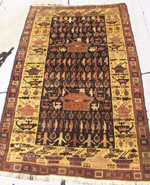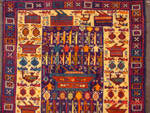Golden Border War Rug with All Over Tank and Airplane Field
Like new condition. Light border wool clumpy with lanolin. The pattern of this rug is unique. Typically golden border rugs are either all over fighter jet designs, rows of tanks, or two ewer designs. This rug uniquely combines fighter jets, tanks, and
High Quality Green Border War Rug$3,499
This rug is remarkable for its fine quality. This rug exemplifies the best of weaving from western Afghanistan: soft, lustrous wool, lovely sheen, dark colors. Strong design. Note the superb luster of this rugs wool. Design alternates between rows of two tanks with text inside and three large ewers. Throughout the negative space sit grenades and small flowers, and the whole field is surrounded by an open guard stripe of linked flowers and leaves. The border consists of tanks, rifles, and helicopters on a green background. The mustard yellow and bright orange accents pop off of the olive green and navy blues. The rug was acquired by Warrug in 2003, and was first offered for sale in 2016.
Tow Ewer with Two Rows Each of Three Helicopters and Two Tanks
Excellent. Artistic use of fluorescent colors. Borders: 1 main with one outside guard stripe. Lots of nice greens and grays. Around light helicopter is natural fields with jade outline over grey outline. Different color, also natural. Thirteen separate colors: beautiful.
Blue Golden Border War Rug
Paired with 974 and has very similar closures and selvedge on the fringe. Has some small areas of darkened dry ice discoloration. Detailed depictions of tanks and helicopters in both the border and the field. The multi-colored zigzag in the fringe is very interesting.
Golden Border Two Ewer Rug with Blue Beads- NEW PHOTOS Former price = 41
This war rug is a new pattern. It comes from western Afghanistan. One interesting feature of the design is the table and ewer motif. These ewers are used in ritual cleansing, and their combination with war motifs is interesting. The colors are stunning, to say the least. The overall composition is lovely. One of the nicest things about this war rug is the artists use of pattern. An example of the artists clever use of pattern can be found in the text. Usually, the Farsi text in these types of war rugs say -tank-, however, she took Farsi letters and instead wove them as part of the overall pattern. The same letters can be found throughout the rug, used in much of the same way that the birds and flowers are used. There are two ewers found at the top and bottom of this war rug. These ewers are used in ritualistic cleansing before prayer. Please note the very interesting and stylized helicopters along the outside border which are only found in this two ewer style of war rugs. Needless to say, the artist of this war rug was extremely talented in not only design, but color use as well. However, we would be remiss not to point out the most amazing, interesting feature we have ever seen in war rugs. It is an important, yet subtle feature to this rug. There are blue glass beads sewn into the selvedge. This is only the second war rug we have seen this on. These blue glass beads were added personally by the weaver, as a token of good luck. These are VERY RARE in war rugs.
Burqa Clad Women Disguised as Airplanes
This rug is an excellent argument for the figures on the top and bottom being women in burkas. The shape is not unlike airplane motifs, but some of these have two definite eyes. These figures contextualize the war in a way not seen often in rugs. This rug places people emotional reaction in the context of the wars. The composition of this rug is beautiful. The two tanks function like irregular medallions. The strong pattern of Kalashnikovs and grenades in the field are beautiful. The small size of the guns and grenades are effectively juxtaposed with the larger form of the tanks, as well as the medium sized mechanized armor motifs in the border. The neon green and red accents work with the gold, pink, blues, and browns against the dark blue field to produce a colorful rug.
(exhibited at Miami University Art Museum)Blue Tank War Rug with Women in Burqas
This fabulous war rug was woven in Afghanistan in 1995. The artist that wove this is of Zakini Baluch ethnicity. War rugs made by the Baluchi tribe have a certain quantifiable quality to them, although not popularly well-known in the U.S. Using workmanship, wool, dye and artistry, there are three levels of quality found throughout rugs made by the Baluchi tribes. The most common of all are simply identified as a Baluchi war rug, then there are the Taimaini Baluch, followed by the Zakini Baluch, with the Zakini sub-tribe representing the very best of the Baluchi war rugs. This war rug is simply stunning, and represents the highest form of folk art. Not only does this war rug speak of the times in which the artist lived, represented by the weaponry, but it also speaks about the world the artist is forced to live in. We are unsure who is the very first weaver to begin to do this with war rugs made during the Taliban era, but hidden among the images is not a row of planes. This is a row of women in burkas. Given that the weavers and artists warrug.com proudly supports are the poster-people for oppression, we would be absolutely remiss to not point out that the artist of this rug is saying I am here. This is my story-. The Taliban strictly follows the laws of the Quran that forbids the depiction of any living thing (when you call to order this rug, ask one of our sales representatives to tell you an interesting story about this sharia law). The artist would have been stoned for depicting herself, so she subtly hides the image within the other weaponry, making the formless shape of the burka cleverly resemble a plane. This is a piece of art the truly tells the story of the weaver: where she lived, when, and how. An excellent reminder to us all how far we have come in the fight for womens rights here in America, and how far we still need to go.
Old War Rug with Burkas
Very unusual and excellent rug. Vintage and shows some age. This rug is an excellent argument for the figures on the top and bottom being women in burkas. The shape is not unlike airplane motifs, but some of these have two definite eyes, and the central figure on the bottom even has a flat red mouth. These figures, especially the one with the sad expression contextualize the war in a way not seen often in rugs. This rug places people emotional reaction in the context of the wars. The composition of this rug is beautiful. The two tanks function like irregular medallions. The strong pattern of Kalashnikovs and grenades in the field are beautiful. The small size of the guns and grenades are effectively juxtaposed with the larger form of the tanks, as well as the medium sized mechanized armor motifs in the border. Color: The colors are lime yellow and almost black brown. Black is a traditional Muslim color of mourning which jibes with the sad face. There is some fading in the yellow, it is more saturated lime green / yellow on the back. Nice geometric guard stripe on the outside. Condition note: please see photos. There is some bleeding of the brown into the yellow border. This is mostly noticeable only from the back. Short pile allover, with very short pile in places, with knots showing. Some colors seem to have oxidized. These things noted, the condition is good. Rug is clean and strong. It still has a lot of life. This is a great piece for a collector, particularly one who is interested in the reality of women in Afghanistan.
Gold Border, Bright Colors, Burkas Afghan War Rug
Interesting pattern for the depiction of what look like women in Burkas. Very bright synthetic colors.
Golden Border with Burkas Afghan War Rug
Very good. Some weft knots popping through pile. Some bleeding of dark brown into natural wool color. Blue in field is very nice with some abrash. Two rows of figures on top and bottom that look like women in burkas.


